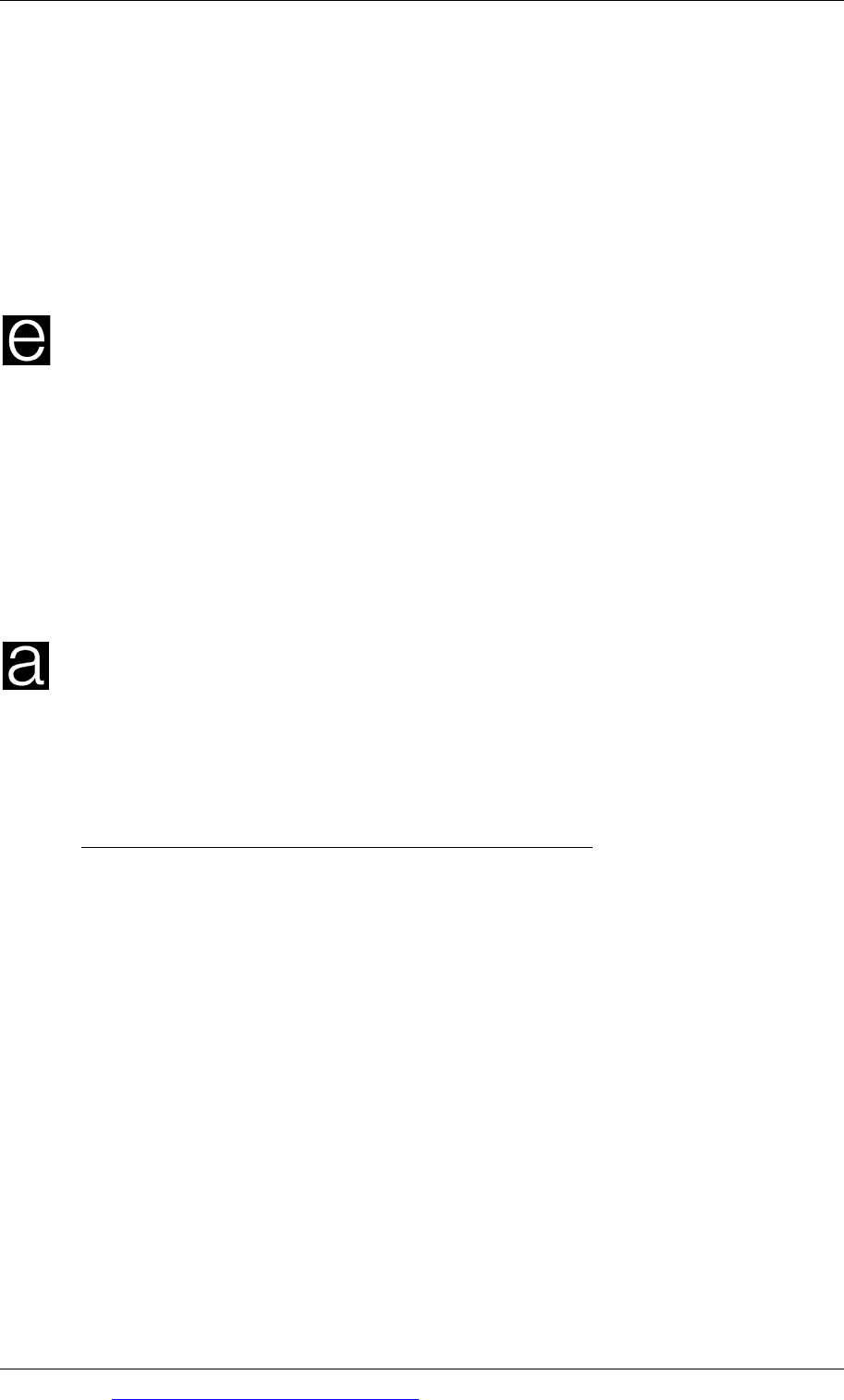ACCA P2 (INT) Corporate Reporting - Study text - 2010 (Emile Woolf)
Подождите немного. Документ загружается.


Chapter 13: Reporting requirements for listed companies
© EWP Go to www.emilewoolfpublishing.com for Q/As, Notes & Study Guides 343
IAS 33: Earnings per share
Introduction and scope
Basic earnings per share
Basic earnings per share and a bonus issue of shares
Basic earnings per share and a rights issue
Diluted earnings per share
Dealing with multiple dilutions
Diluted losses
ED: Simplifying Earnings per Share
2 IAS 33: Earnings per share
2.1 Introduction and scope
Earnings per share (EPS) is a key ratio used by investors to assess the performance
of a company. It provides a measure of the profit attributable to each ordinary
shareholder during the year. The EPS for both this year and the previous year must
be disclosed in the annual financial statements.
The disclosure should be made in the statement of comprehensive income, unless it
presents the components of profit or loss in a separate income statement, in which
case the EPS information should be disclosed in the income statement.
Basic EPS should be calculated by dividing the net profit or loss for the period
attributable to ordinary shareholders by the weighted average number of ordinary
shares outstanding during the period.
IAS 33 Earnings per share applies to entities whose ordinary shares are publicly
traded and by entities that are in the process of issuing ordinary shares in a public
market. EPS is therefore usually calculated from consolidated accounts.
This is not a key standard for the exam, so you will need to know this in outline.
Any questions set are likely to be testing adjustments that affect the earnings figure
which in turns affects the EPS.
2.2 Basic earnings per share
IAS 33 specifies how earnings per share should be calculated. This is to ensure that
measurements of EPS by different entities can be properly compared with each
other.
Earnings per share =
Earnings
Number of ordinary shares in issue

Paper P2: Corporate Reporting (International)
344 Go to www.emilewoolfpublishing.com for Q/As, Notes & Study Guides © EWP
Earnings are the profit (or loss) after tax from continuing operations that are
attributable to the ordinary equity shareholders. With consolidated accounts,
earnings are the profits after tax from continuing operations that are attributable to
ordinary equity shareholders of the parent company (excluding the profit
attributable to non-controlling interests).
Preference dividends are deducted in arriving at the profit attributable to ordinary
equity shareholders. Preference dividends should normally only be deducted from
profit after tax to calculate a figure for earnings if they have already been declared
by the end of the financial year. This is because the company does not have an
obligation to pay the dividend unless it is declared. However, there is an exception
in the case of dividends on ‘cumulative preference shares’. When a company has
cumulative preference shares, the dividend that should be paid must be deducted
from profit after tax to calculate earnings, even if it has not yet been formally
declared. This is because if no dividend is declared, the entitlement of the
shareholders to their dividend remains. There is an obligation on the company to
pay the dividend, and this carries forward to the next financial year, until the
dividend is eventually paid.
Number of ordinary shares in issue. This is the weighted average number of
ordinary shares during the period. Calculating the number of shares in issue can be
fairly complicated.
When shares are issued during the financial year
at a full market price, the number
of shares is a weighted average number of shares in issue during the year. This can
be calculated as follows:
Number of shares at the beginning of the year, plus A
Number of shares issued at full market price during the year
× [Number of months in the year after the share issue /12]
B
Weighted average number of shares in the year A + B
Example
A company issued 20,000 ordinary shares at their market price of $5 per share on 1
July 20X7. Its share capital prior to the issue was 200,000 and its profits after tax
were $50,000 for the year to December 20X6 and $70,000 for the year to 31 December
20X7.
The shares were issued at full market price.
The earnings per share in each year are calculated as follows:
20X6: EPS = $50,000/200,000 shares = $0.25
20X7: Weighted average number of shares = 200,000 + (20,000 × 6/12) = 210,000
EPS = $70,000/210,000 shares = $0.33.

Chapter 13: Reporting requirements for listed companies
© EWP Go to www.emilewoolfpublishing.com for Q/As, Notes & Study Guides 345
Partly-paid shares
The EPS is based on the number of fully-paid ordinary shares. Sometimes shares are
issued with the money collected in stages, so if there are any shares which are not
fully paid up by the end of the reporting period, then the equivalent number of fully
paid shares must be established for use in the formula.
Example
At 1 January 20X7 a company had 100,000 $1 shares in issue, of which 800,000 are
fully paid up. The rest of the shares in issue were paid up to $0.75.
The remaining $0.25 on the partly-paid shares was collected on 30 June 20X7.
The weighted average number of shares in 20X7 is calculated as follows:
Fullypaid
1Januaryto31December–fullypaidup
800,000
Partlypaid
1Januaryto30June–paidupto75c:200,000×75c×6/12 = 75,000
1Julyto31December–fullypaid‐up:200,000×$1×6/12
= 100,000
Weightedaveragenumberofordina rysharesforEPScalculation
975,000
2.3 Basic earnings per share and a bonus issue of shares
A company may make a free issue of shares to its existing shareholders. This is
called a bonus issue, scrip issue or capitalisation issue. The issue does not bring any
new cash into the company and so cannot be expected to increase the total earnings.
The problem for calculating EPS when there has been a bonus issue in the period is
that it distorts the comparison of EPS in the current year with the EPS in the
previous year (for which a comparative figure is shown in the statement of
comprehensive income or income statement). So to ensure that the bonus issue does
not distort the comparison of EPS in the current year and previous year:
the EPS for the current year is calculated as if the bonus issue took place at the
start of the year, and
the previous year’s EPS is also re-stated as though the bonus shares had been in
existence throughout the whole of that year too.
Example
A company has a share capital of 400,000 ordinary shares, when it decides to make a
bonus issue of 1 for 4 on 1 April 20X6. Its profits for the year to 31 December 20X5
were $60,000 and its profits for the year to 31 December 20X6 were $65,000.
The EPS originally calculated in the financial statements for 20X5 was:
= $60,000/400,000 shares = $0.15.

Paper P2: Corporate Reporting (International)
346 Go to www.emilewoolfpublishing.com for Q/As, Notes & Study Guides © EWP
After the bonus issue in 20X6, when the company issues another 100,000 shares (1/4
× 400,000) there are 500,000 shares. To calculate the EPS for 20X6, it is assumed that
all these shares were in issue for the full year.
EPS for 20X6 = $65,000/500,000 shares = $0.13.
The EPS in 20X5 was $0.15 and the EPS in 20X6 is $0.13. This comparison would
suggest that the EPS has gone down, and the company has therefore performed
worse in 20X6. This is clearly not true: total earnings have gone up. The only
difference between 20X5 and 20X6 is that the company issued some free shares.
To make the EPS for 20X6 and 20X5 properly comparable, we have to adjust the EPS
for 20X5 for the purpose of making the comparison in the 20X6 financial statements,
assuming that 500,00 shares were in issue throughput 20X5 as well as 20X6.
Re-stated EPS for 20X5 = $60,000/500,000 shares = $0.12.
Alternatively, to calculate the re-stated EPS for the previous year the original EPS in
20X5 of 15p can be adjusted by the ‘bonus fraction’ to recognise that 400,000 shares
have now become 500,000 shares.
$0.12=
500,000
400,000
issue bonusafter shares ofNumber
shares ofnumber Original
$0.15 EPS Original ×
Both the 20X6 figure for EPS and the re-stated 20X5 figure will be presented at the
bottom of the statement of comprehensive income (or the income statement, if this is
presented separately) in the 20X6 financial statements.
2.4 Basic earnings per share and a rights issue
A rights issue of shares is an issue of new shares for cash, where the new shares are
offered initially to current shareholders in proportion to their existing
shareholdings. The issue price of the new shares in a rights issue is always below
the current market price for the shares already in issue.
Because rights issues are usually at less than full market price they include a bonus
element. Since there is a bonus element in the issue price, an adjustment is needed
for the EPS calculation, to ensure a fair comparison of the current year EPS with the
previous year EPS.
Current year EPS
To adjust for the bonus element in the rights issue, the number of shares in the
current financial year must be adjusted. You should multiply the number shares in
issue before the rights issue by a factor (a ‘rights factor) of:
Actual cum rights price
Theoretical ex rights price
Theoretical ex-rights price is explained and illustrated later.

Chapter 13: Reporting requirements for listed companies
© EWP Go to www.emilewoolfpublishing.com for Q/As, Notes & Study Guides 347
Previous year EPS
In addition, to provide a fair comparison of the current year EPS with the previous
year’s EPS, the comparative EPS for the previous year is obtained by adjusting the
EPS actually reported last year. The previous year’s EPS is reduced by the following
factor:
Theoretical ex rights price
Actual cum rights price
The
actual cum-rights price is the market price of the shares before the rights issue.
The
theoretical ex-rights price is the price that the shares ought to be, in theory,
after the rights issue. It is a weighted average price of the shares before the rights
issue and the new shares in the rights issue. If you are not sure how to calculate the
theoretical ex-rights price, study the following example carefully.
Example
Entity L had 36,000,000 shares in issue on 1 January Year 2. It made a 1 for 4 rights
issue on 1 June Year 2, at a price of $4 per share. The share price just before the
rights issue was $5.
Total earnings in the financial year to 31 December Year 2 were $25,125,000. The
reported EPS in Year 1 was $0.64.
Required
Calculate the EPS for the year to 31 December Year 2, and the adjusted EPS for Year
5 for comparative purposes.
Answer
After the rights issue, there will be 1 new share for every 4 shares previously in issue
$
4existingshareshavea‘cumrights’valueof (4 ×$5) 20.00
1newshareisissuedfor 4.00
–––––
5sharesaftertheissuehaveatheoreticalvalueof 24.00
–––––
Theoretical ex-rights price = $24.00/5 = $4.80.

Paper P2: Corporate Reporting (International)
348 Go to www.emilewoolfpublishing.com for Q/As, Notes & Study Guides © EWP
Date
Number
ofshares
Time
factor
Rights
fraction
Weighted
average
number
ofshares
1Jan Broughtforward 36,000,000 ×5/12 ×5.00/4.80 15,625,000
1June Rightsissue(1for4) 9,000,000
⎯
⎯
⎯
⎯
⎯
⎯
⎯
⎯
⎯
⎯
31Dec Carriedforward 45,000,000 ×7/12 26,250,000
⎯
⎯
⎯
⎯
⎯
⎯
⎯
⎯
⎯
⎯
41,875,000
⎯
⎯
⎯
⎯
⎯
⎯
⎯
⎯
⎯
⎯
EPS Year 2 = $25,125,000/41,875,000 = $0.60, or 60c
Comparative EPS in Year 1 = $0.64 × ($4.80/$5.00) = $0.6144 or 61.44c.
Example
Entity M had 3 million ordinary shares in issue on 1 January Year 7. On 1 April Year
7, it made a 1 for 2 rights issue of 1,500,000 ordinary shares at $2 per share. The
market price of the shares prior to the rights issue was $5.
An issue of 400,000 shares at full market price was then made on 1 August Year 7.
In the year to 31 December Year 7, total earnings were $1,746,875. In Year 6 EPS had
been reported as $0.35.
Required
Calculate the EPS for the year to 31 December Year 7, and the adjusted EPS for Year
6 for comparative purposes.
Answer
After the rights issue, there will be 1 new share for every 2 shares previously in
issue
$
2existingshareshavea‘cumrights’valueof (2×$5) 10.00
1newshareisissuedfor 2.00
⎯
⎯
⎯
⎯
⎯
⎯
3sharesaftertheissuehaveatheoreticalvalueof 12.00
⎯
⎯
⎯
⎯
⎯
⎯
Theoretical ex-rights price = $12/3 = $4.

Chapter 13: Reporting requirements for listed companies
© EWP Go to www.emilewoolfpublishing.com for Q/As, Notes & Study Guides 349
Date
Number
ofshares
Time
factor
Rights
fraction
Weighted
average
numberof
shares
1Jan Broughtforward 3,000,000 ×3/12 ×5/4 937,500
1April Rightsissue(1for2) 1,500,000
⎯
⎯
⎯
⎯
⎯
⎯
⎯
⎯
⎯
4,500,000 ×4/12 1,500,000
1August Issueatmarketprice 400,000
⎯
⎯
⎯
⎯
⎯
⎯
⎯
⎯
⎯
4,900,000 ×5/12 2,041,667
⎯
⎯
⎯
⎯
⎯
⎯
⎯
⎯
⎯
⎯
4,479,167
⎯
⎯
⎯
⎯
⎯
⎯
⎯
⎯
⎯
⎯
EPS Year 7 = $1,746,875/4,479,167 = $0.39, or 39c
EPS Year 6 = $0.35 × 4.00/5.00 = $0.28 or 28c.
2.5 Diluted earnings per share
In addition to the basic measure of EPS, a company must also disclose the diluted
EPS in its statement of comprehensive income (or income statement, if presented
separately). Diluted EPS warns existing shareholders that the EPS may fall in future
years because of
potential new ordinary shares that have been issued. Potential
new ordinary shares may become actual ordinary shares at some time in the future
Potential new ordinary shares may be issued in any of the following forms:
Convertible bonds: (bonds or debentures that can be converted into ordinary
shares in the future, at the option of the bondholders)
Convertible preference shares: (preference shares that can be converted into
ordinary shares in the future, at the option of the preference shareholders)
Options and warrants: (holders of options and warrants have the right to buy
ordinary shares in the future at a predetermined fixed price)
Contingently-issuable shares: (these are ordinary shares that will be issued if
certain conditions are met)
Employee incentive schemes (share options issued to the company’s employees).
The owners of these instruments may become ordinary shareholders in the future. If
this happens, the company’s earnings will be shared by a larger number of
shareholders. There is a strong possibility that the EPS may fall, and the EPS will
become ‘diluted’. (‘Diluted’ means ‘watered down’, and in relation to EPS, it means
‘lower’.)
The diluted EPS is calculated by revising the total earnings and the weighted
average number of shares as though the potential ordinary shares had already been
issued.

Paper P2: Corporate Reporting (International)
350 Go to www.emilewoolfpublishing.com for Q/As, Notes & Study Guides © EWP
The original earnings figure is revised by adjusting it for the dilutive effect of the
potential ordinary shares when they become actual ordinary shares. An adjustment
to total earnings is needed for convertible preference shares and convertible bonds.
If convertible preference shares (potential ordinary shares) became actual
ordinary shares, there would be a reduction in preference dividend, so total
earnings would be higher.
If convertible bonds (potential ordinary shares) became actual ordinary shares,
there would be a reduction in interest costs (although there would no longer be
tax relief on the interest costs), and total earnings would be higher.
When calculating the revised weighted average number of shares, the potential
ordinary shares are deemed to have been converted into ordinary shares at the
beginning of the period or, if later, the date of the issue.
Only dilutive shares should be included in the diluted EPS calculation.
Potential new ordinary shares are not dilutive if EPS would have been higher if
the potential shares had been actual shares in the period.
Potential ordinary shares are dilutive when their conversion to ordinary shares
decreases the EPS from continuing operations.
Diluted EPS and convertible debt and preference shares
Convertible instruments have two possible effects on EPS.
Total earnings will increase because the interest or preference dividend will no
longer be payable. With convertible debt, the tax relief on the interest will be
lost, so the increase in total earnings is the interest no longer payable, minus the
associated tax relief.
The weighted average number of shares will increase.
The holders of the convertible debt or shares may have a choice of dates for
conversion, and the rate of conversion into ordinary shares is often different for
each conversion date. IAS 33 requires the best rate (from the holder’s view) to be
used.
Example
On 1 January Year 1, a company has 700,000 ordinary shares in issue. On 31 March
Year 1, the company issues $200,000 6% convertible debentures. The terms of
conversion are as follows:
(1) 100 shares per $100 debt if conversion takes place by 30 June Year 3
(2) 110 shares per $100 debt if conversion takes place by 30 June Year 5
The profit for the year to 31 December Year 1 is $200,000 and the tax rate is 33%.
The
basic EPS for Year 1 is $200,000/ 700,000 = $0.29

Chapter 13: Reporting requirements for listed companies
© EWP Go to www.emilewoolfpublishing.com for Q/As, Notes & Study Guides 351
Diluted EPS
As there is a choice of dates for conversion, IAS 33 requires that the diluted EPS
calculation uses the best conversion rate from the holder’s view. This will be 110
shares per $100 of debt. This would result in an additional 220,000 shares being
issued ($200,000 × 110/100).
The company will save $12,000 in annual interest costs when the debt converts (6%
× $200,000) but it will lose the tax relief on the interest. The tax relief is $12,000 ×
33% = $3,960.
The diluted EPS for Year is therefore calculated as follows:
Numberofshares
Earnings
$
Existingshares 700,000
200,000
Newsharesonconversion 220,000
Interestsaved
12,000
Taxrelieflost
(3,960)
Adjustedamounts 920,000
208,040
Diluted EPS = $208,040/920,000 shares = $0.23.
Diluted EPS and share options and warrants
Share options and share warrants allow the holder the right to buy new ordinary
shares at a future date, at a predetermined fixed price that is often lower than the
current market price for the shares. If the options or warrants are ‘exercised’, the
company will issue new shares and will receive less money than it would if the
shares had been issued at the full market price.
When options or warrants have an exercise price that is less than the market price,
there is a dilutive effect on EPS, and a diluted EPS must be calculated.
The technique for calculating diluted EPS for options and warrants is different from
the technique for convertible preference shares or convertible debt. This is because a
different situation applies with share options and share warrants. If these are
exercised, the holders of the options or warrants will pay cash to obtain new
ordinary shares.
If the options or warrants are exercised, the entity will receive cash that it can
invest to increase earnings. However, since the options or warrants have not yet
been exercised, it is impossible to predict how total earnings will be affected
when the cash is eventually received.
The exercise price for the options or warrants will be less than the full market
price for the shares. This means that there will be a bonus element in the issue.
These factors complicate the calculation of diluted EPS, but IAS33 has provided a
solution, as follows.

Paper P2: Corporate Reporting (International)
352 Go to www.emilewoolfpublishing.com for Q/As, Notes & Study Guides © EWP
Calculate the number of shares that will be issued if all the options or warrants
are exercised.
Reduce this figure by the number of shares that could be purchased at full
market price with the cash received from the exercise of the options or warrants.
The market price of the shares should be the average market price during the
period (the financial year).
This net figure is then added to the existing number of shares in issue, to obtain
the total shares for calculating the diluted EPS.
Example
Entity P had total earnings during Year 3 of $1,030,000.
It has 5,000,000 ordinary shares in issue. There are outstanding share options on
400,000 shares, which can be exercised at a future date, at an exercise price of $2.50
per share. The average market price of shares in Entity P during Year 3 was $4.
Required
Calculate the diluted EPS for Year 3.
Answer
Cash receivable on exercise of all the options = 400,000 × $2.50 = $1,000,000.
Number of shares this would buy at full market price in Year 3 = $1,000,000/$4 =
250,000 shares.
Shares
Options 400,000
Minusnumberofsharesatfairvalue (250,000)
⎯
⎯
⎯
⎯
⎯
⎯
⎯
⎯
⎯
Netdilution 150,000
Existingsharesinissue 5,000,000
⎯
⎯
⎯
⎯
⎯
⎯
⎯
⎯
⎯
Totalshares 5,150,000
⎯
⎯
⎯
⎯
⎯
⎯
⎯
⎯
⎯
Diluted EPS = $1,030,000/5,150,000 = $0.20 or 20c.
Contingently-issuable shares
Contingently-issuable shares are ordinary shares issued for little or no cash when
another party satisfies certain conditions. They may, for example be issued to
employees if certain performance targets are met over a period of time, under the
terms of a share grant incentive scheme.
Such shares should be included in the diluted EPS calculation if the conditions or
targets have been met, and should be included from the beginning of the period, or
